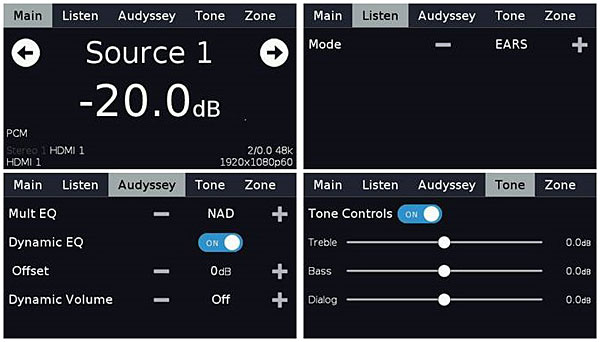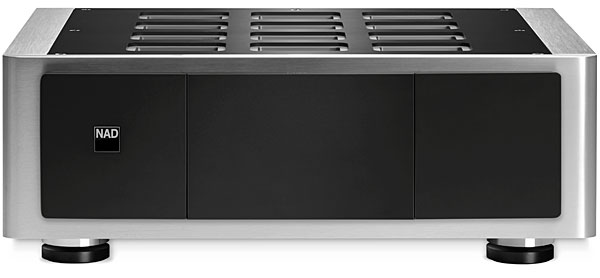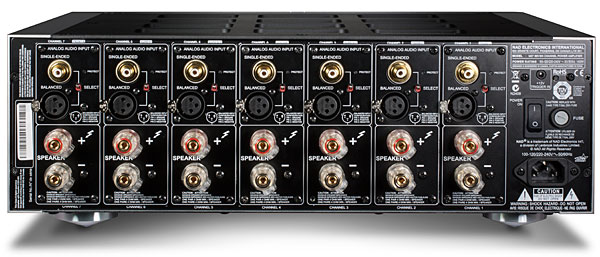| Columns Retired Columns & Blogs |
Music in the Round #70 Page 2
The M17 sits on four large, broad spikes, for which NAD provides concave protective plates that center themselves magnetically. Installation was a breeze, and setup involved minimal but predictable use of the M17's menus. I connected the M17's XLR outputs to my Bryston 9BST amp and, later, to NAD's own M27, but fed the RCA outputs to my two subwoofers. After setup, the OSD wasn't needed—the excellent and informative front-panel touchscreen, with its crisp text, sufficed for all normal operations (fig.1). In fact, the M17's is the best info display yet, but is compromised by a niggling issue: Remember, the touch-sensitive Standby/On switch is at the center of the top edge, just where I'm likely to rest my hand when using the touchscreen. You can imagine how infuriating it was to be continually turning off the M17 just when I wanted to interact with it. It took me weeks to learn not to do that, and I still sometimes forget.
Footnote 1: NAD Electronics International, 633 Granite Court, Pickering, Ontario L1W 3K1, Canada. Tel: (905) 831-6555. Fax: (905) 831-6936. Web: www.nadelectronics.com.
On the other hand, the M17's remote control was an unalloyed delight: slim, and just hefty enough to feel good in the hand. Illumination is automatic, and the button array is logical. I particularly appreciated being able to directly access Audyssey MultEQ XT with a single button, and three rocker switches permit the immediate adjustment of the surround, center, and subwoofer channels.
The M17's sound, too, was delightful. I used it for a few weeks without Audyssey, connected, via the M27 or my Bryston 9BST power amp, to the Monitor Audio Silver 8 or Paradigm Studio/60 v.3 speakers. There are no multichannel analog inputs, and the stereo inputs are digitized at the M17's internal processing bandwidth of 24-bit/192kHz. In practice, the analog inputs sounded transparent, but direct A/B comparisons weren't possible. The digital inputs accept 24/192, and were deliciously transparent in stereo or multichannel. I could pick out individual voices from a 5.1-channel recording of Robert Hollingworth conducting I Fagiolini in a Mass by Alessandro Striggio, Ecco sç beato giorno (DVD, Decca B0015655-00), and enjoy the tonal richness of the 40-part scoring. With this and more conventional music, the M17 gave as good as it got.
Dynamics were precise and satisfying, and bass was delivered with authority. A new and interesting recording of Fauré's Requiem, with Stephen Cleobury conducting the Choir of King's College, Cambridge, and the Orchestra of the Age of Enlightenment (SACD/CD, Kings College Choir KGS0005), had wonderful ambience. It's less spacious but more enveloping than my favorite recording of this work, with Paavo Järvi leading the Orchestra de Paris and Chorus (BD, EuroArts 2058874), and the carpet of organ tone makes it special. It also seems more reverent than Järvi's more rhapsodic interpretation. On the other hand, a recording of orchestral works by Bart¢k, Hindemith, and Prokofiev, with Michael Stern conducting the Kansas City Symphony (SACD, Reference RR-132SACD), was almost too much through this system, and was definitely too much through my reference system, in Manhattan. The rich ambience and dynamic bass that put Prof. Keith Johnson's stereo recordings in their own class seem over the top in multichannel. Reverting to stereo, the M17 was just wonderful via either amp and either set of speakers.

Playing hi-rez and/or multichannel files from my server, connected to the M17 via HDMI, was simply glorious, especially as these signals were passed through a Dirac Live speaker-and-room–correction filter set at 24/96. The M17 doesn't accept DSD signals, but Dirac Live also imposes a PCM requirement, so these results stand on an equal footing with those from other pre-pros.
Having achieved great satisfaction so far, I ran an Audyssey calibration. The M17 is supplied with MultEQ XT, and not the latest version, XT32. This means that it has a more limited and less effective filter set, and that, despite the M17's dual subwoofer outputs, both subs are treated as one for all measurements and corrections. The calibration process was uneventful, and assigned all of my speakers to be Large—a common outcome with my speakers and any room-correction software. The sound was much improved, with some additional presence and detail in the midrange and a tightening of the bass. Unlike most pre-pros, the M17 passes hi-rez sources through Audyssey at 24/96 without downsampling to 24/48. I especially appreciated this with the optional NAD correction target curve.
I then adjusted bass management to reassign my main speakers as Small by setting a 40Hz crossover for the L/C/R and an 80Hz crossover for the smaller surrounds. This was a disaster: The bass became lumpy, with a droning subwoofer output that seemed to hum along with the main channels, even with unaccompanied voices. I was forced to revert to the Audyssey-chosen full-range settings for all speakers. The solution was to use the Pro calibration option. With that, I could achieve high-quality results and bass management. I interpret this to mean that it is not the M17's inability to independently measure and calibrate the subs that is problem. It might be a microphone issue, or that my two attempts with Audyssey were flawed, as they sometimes are.
Its price of $5499 places the M17 at the upper end of pre-pros, where it competes ably with the $6500 Krell Foundation that I reviewed in May 2014 in terms of basic sound quality. I preferred the M17's elegant appearance and its user interface by wide margins, but felt that their abilities in room equalization were a toss-up. Both lack any useful streaming capabilities, but while the Krell has more features, including pure analog inputs, the M17's modular design presages relatively painless upgrades. Of course, many lower-priced pre-pros have even more comprehensive feature sets; however, unlike the M17, they are constrained by downsampling when Audyssey is used.
Overall, I was extremely pleased by the performance of and my interactions with NAD's Masters Series M17. In fact, if NAD will accommodate me, I intend to hang on to it, in anticipation of the release of the USB/Bluesound module, and report on it again.
NAD Masters Series M27 seven-channel power amplifier
In some ways, the power amplifiers released with a new pre-pro can seem afterthoughts, as if intended merely as a response to a marketer's demand that "We gotta have something to match the new processor." NAD's Masters M27 seven-channel power amp, however, is no mere afterthought to the Masters M17 pre-pro.
NAD has developed quite successful conventional analog and class-D power amplifiers (see JA's review of their Masters M2 Direct Digital amplifier to which I referred earlier ). This time, however, they've adopted a technology that has recently made inroads into the High End: Hypex's nCore, based on their UcD concept.

UcD is, fundamentally, a PWM amplifier that is DC-coupled from end to end, lacking even an output-blocking relay. The latter is replaced by much faster electronic protection. DC protection also includes a useful 2Hz, 12dB/octave high-pass characteristic, via not a traditional DC servo but a feed-forward design that takes a low-passed signal derived from the input and subtracts it from the main signal at a later stage. The nCore design makes use of negative feedback and uses a modulator that was linearized using a mathematical analysis of oscillator behavior. The distortion and output impedance remain low over the while spectrum.
The size and lovely appearance of the Masters M27 ($3999) perfectly match the M17's. It sits on the same large spikes fitting the magnetically attached protective pucks, if you choose to use the latter. The same black front panel now bears only the illuminated NAD logo, which again indicates the power status. The actual Standby/On switch is on the top, and operates similarly to the M17's—or, at least, it should. The review sample's switch was defective and unpredictable in its response; I usually had to touch it multiple times before the M27 would turn on or off.
On the rear panel are connections for the seven amplifier modules. Each is populated with, from top to bottom, single-ended (RCA) and balanced (XLR) inputs, and a pair of substantial multiway speaker terminals. To the right of each pair of inputs is a toggle to select between them. Each amp module also has a Protect LED, to indicate its operational status. At the far right of the rear panel, from the top down, are a 12V trigger input and a dimmer for the front-panel LED, followed by the master Power switch, the fuse bay, and the IEC AC inlet. Had I used that trigger input, the tricky front-panel switch wouldn't have mattered.
The sound of the M27 was notably clean and punchy. By punchy I don't mean that anything was added or out of place, but that in terms of frequency response, transient response, and dynamics, the M27's sound was so well delineated that bass notes were as discrete as notes in higher ranges. Another way to describe this is as a lack of smearing. The midrange and treble were completely free of any grain or, significantly, the grayish character that is a consistent flaw in the sounds of many of the otherwise excellent class-D amps I've used. A listener can adapt to that, but the M27 makes no such demands.

The claimed power output for each module is 250W into 8, 4, or 2 ohms, with dynamic power (1kHz, 10ms) of 350W into 8 ohms and >600W into 4 or 2 ohms. Obviously, in a seven-channel amplifier, each channel's output would be limited by the power supply and the AC supply. NAD lists the M27's output as equal to or greater than 180Wpc with all channels driven. Given that I used no more than five channels, my expectation is that the power output is more than I can use, which means that, in practice, it was limitless.
Compared to my five-channel Bryston 9BST ($8095), which has a similar power spec but is limited only by the AC supply (each channel has its own power supply), the sound of the M27 was, delightfully, a bit more forward. My preference shifted with the recording—the Bryston's slight reticence could sometimes tame an aggressive signal. Overall, it was hard to decisively choose between them, though the M27's appearance, efficiency, and lower price probably make it the more attractive option today.
The NAD Masters Series M27 is much more than just a pretty face offered as a mate for the Masters M17. It has oomph enough for most setups, runs quietly and efficiently, and, best of all, is transparent in its task: amplification. Whether or not the M17 appeals to you, the M27 must be considered for any multichannel system.
Footnote 1: NAD Electronics International, 633 Granite Court, Pickering, Ontario L1W 3K1, Canada. Tel: (905) 831-6555. Fax: (905) 831-6936. Web: www.nadelectronics.com.
- Log in or register to post comments




































